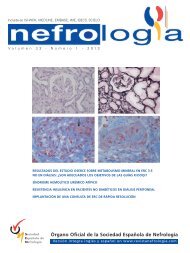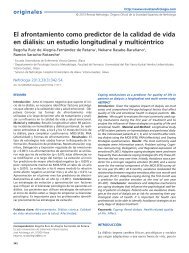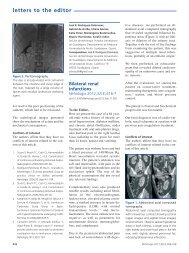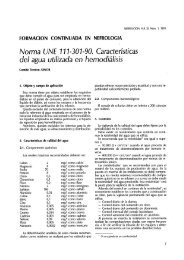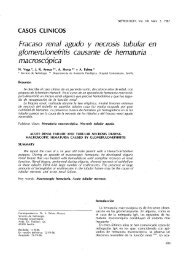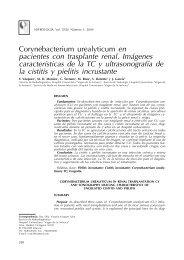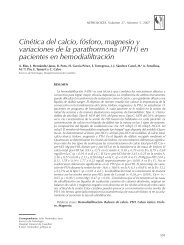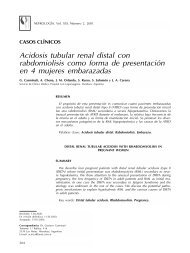PDF Número - NefrologÃa
PDF Número - NefrologÃa
PDF Número - NefrologÃa
You also want an ePaper? Increase the reach of your titles
YUMPU automatically turns print PDFs into web optimized ePapers that Google loves.
evisiones cortas<br />
S. Ros Ruiz et al. Diálisis peritoneal y ascitis<br />
CONCEPTOS CLAVE<br />
1. La prevalencia de coexistencia de enfermedad<br />
renal crónica y cirrosis hepática se está incrementando<br />
debido a la prevalencia creciente de<br />
ambas enfermedades.<br />
2. El seguimiento estrecho de estos pacientes es<br />
necesario para determinar el momento de inicio<br />
de diálisis debido a la dificultad para determinar<br />
con exactitud el filtrado glomerular y a<br />
que presentan síntomas similares.<br />
3. La tendencia espontánea hacia la hipotensión<br />
arterial e inestabilidad hemodinámica y mayor<br />
riesgo de sangrado en los pacientes cirróticos<br />
hacen de la hemodiálisis una tarea difícil.<br />
4. Debido que la paracentesis evacuadora periódica<br />
es el tratamiento de elección en los pacientes<br />
cirróticos con ascitis, el drenaje continuo<br />
y lento del líquido peritoneal mediante<br />
la diálisis peritoneal se asemeja al tratamiento<br />
habitual de estos pacientes, incluso a largo<br />
plazo.<br />
5. El temor de un mayor riesgo de peritonitis con<br />
la diálisis peritoneal no se ha demostrado de<br />
forma clara, y sí se han observado menores<br />
complicaciones hemorrágicas y una mejor tolerancia<br />
hemodinámica, así como una menor<br />
transmisión de la hepatitis B y C frente a la hemodiálisis.<br />
6. Por tanto, la diálisis peritoneal debería considerarse<br />
como una alternativa de diálisis viable<br />
y efectiva para este grupo de pacientes.<br />
REFERENCIAS BIBLIOGRÁFICAS<br />
1. Jang JW. Current status of liver diseases in Korea: Liver cirrosis. Korean<br />
J Hepatol 2009;15(6)(Suppl):40-9.<br />
2. D’Amico G, Pagliaro L, Bosch J. The treatment of portal hypertension:<br />
A meta-analytic review. Hepatology 1995;22:332-54.<br />
3. Floras JS, Legault L, Morali M, Hara K, Blendis LM. Increased sympathetic<br />
outflow in cirrhosis and ascites: Direct evidence from intraneural<br />
recordings. Ann Intern Med 1991;114:373-80.<br />
4. Ginés P, Arroyo V, Quintero E. Comparison of paracentesis and diuretics<br />
in the treatment of cirrhotics with tense ascites: Results of a randomized<br />
study. Gastroenterology 1987;93:234-41.<br />
5. Ochs A. The transjugular intrahepatic portoystemic stent-shunt procedure<br />
for refractory ascites. N Engl J Med 1995;332:1192-7.<br />
6. Pinto PC, Amerian J, Reynolds TB. Large-volume paracentesis in nonedematous<br />
patients with tense ascites: Its effect on intravascular volume.<br />
Hepatology 1988;8:207-10.<br />
7. Conn H, Atterbury C. Cirrhosis: Diseases of the liber, 7th edition. In:<br />
Schiff L, Schiff E (eds.). Philadelphia: Lippencott Company; 1993. p. 875.<br />
8. Runyon BA. Care of patients with ascites. N Engl J Med 1994;330:337-<br />
42.<br />
9. Ginés P, Quintero E, Arroyo V. Compensated cirrhosis: natural history<br />
and prognostic factors. Hepatology 1987;7:122-8.<br />
10. Runyon BA. AASLD Practice Guidelines Comitee. Management of<br />
adult patients with ascites due to cirrhosis: an update. Hepatology<br />
2009;49:2087-107.<br />
11. Lieberman FL, Denison EK, Reynolds TB. The relationship of plasma<br />
volume, portal hypertension, ascites, and renal sodium retention in<br />
cirrhosis: The overflow theory of ascites formation. Ann NY Acad Sci<br />
1970;170:292-5.<br />
654<br />
12. Schrier RW, Arroyo V, Bernardi M, Epstein M, Henriksen JH, Rodés<br />
J. Peripheral arterial vasodilation, hypothesis: a proposal for the initiation<br />
of renal sodium and water retention in cirrhosis. Hepatology<br />
1988;8:1151-7.<br />
13. Asbert M, Ginés A, Ginés P, Jiménez W, Claria J, Saló J, et al. Circulating<br />
levels of endothelin in cirrhosis. Gastroenterology<br />
1993;104:1485-91.<br />
14. Wensing G, Lotterer E, Link I, Hahn EG, Fleig WE. Urinary sodium<br />
balance in patients with cirrhosis: relationship to quantitative parameters<br />
of liver function. Hepatology 1997;26:1149-55.<br />
15. Arroyo V, Clària J, Salo J, Jiménez W. Antidiuretic hormone and the<br />
pathogenesis of water retention in cirrosis with ascites. Semin Liver<br />
Dis 1994;14:44-58.<br />
16. Ros J, Jiménez W, Lamas S. Nitric oxide production in arterial vessels<br />
of cirrhotic rats with ascites: role of endogenous nitric oxide. Hepatology<br />
1992;15:343-60.<br />
17. Clària J, Jiménez W, Ros J, Rigol M, Angeli P, Arroyo V, et al. Pathogenesis<br />
of arterial hypotension in cirrhotic rats with ascites: role of<br />
endogenous nitric oxide. Hepatology 1992;15:343-9.<br />
18. Moore KP, Wong F, Ginés P, Bernardi M, Ochs A, Salerno F, et al.<br />
The management of ascites in cirrhosis: report on the consensus<br />
conference of the international Ascites Club. Hepatology<br />
2003;38:258-66.<br />
19. Stanley MM, Ochi S, Lee KK, Nemchausky BA, Greenlee HB, Allen<br />
JI, et al. Peritoneovenous shunting as compared with medical treatment<br />
in patients with alcoholic cirrhosis and massive ascites. Veterans<br />
Administration Cooperative Study on Treatment of alcoholic cirrhosis<br />
with ascites. N Engl J Med 1989;321:1632-8.<br />
Nefrologia 2011;31(6):648-55



